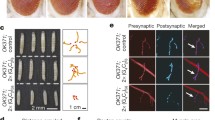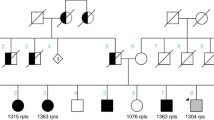Abstract
Friedreich ataxia (FRDA) is caused by homozygosity for FXN alleles containing an expanded GAA triplet-repeat (GAA-TR) sequence. Patients have progressive neurodegeneration of the dorsal root ganglia (DRG) and in later stages the cerebellum may be involved. The expanded GAA-TR sequence is unstable in somatic cells in vivo, and although the mechanism of instability remains unknown, we hypothesized that age-dependent and tissue-specific somatic instability may be a determinant of the progressive pathology involving DRG and cerebellum. We show that transgenic mice containing the expanded GAA-TR sequence (190 or 82 triplets) in the context of the human FXN locus show tissue-specific and age-dependent somatic instability that is compatible with this hypothesis. Small pool PCR analysis, which allows quantitative analysis of repeat instability by assaying individual transgenes in vivo, showed age-dependent expansions specifically in the cerebellum and DRG. The (GAA)190 allele showed some instability by 2 months, progressed at about 0.3–0.4 triplets per week, resulting in a significant number of expansions by 12 months. Repeat length was found to determine the age of onset of somatic instability, and the rate and magnitude of mutation. Given the low level of cerebellar instability seen by others in multiple transgenic mice with expanded CAG/CTG repeats, our data indicate that somatic instability of the GAA-TR sequence is likely mediated by unique tissue-specific factors. This mouse model will serve as a useful tool to delineate the mechanism(s) of disease-specific somatic instability in FRDA.





Similar content being viewed by others
References
Al-Mahdawi S, Pinto RM, Ruddle P, Carroll C, Webster Z, Pook M (2004) Genomics 84:301–310
Anvret M, Ahlberg G, Grandell U, Hedberg B, Johnson K, Edstrom L (1993) Larger expansions of the CTG repeat in muscle compared to lymphocytes from patients with myotonic dystrophy. Hum Mol Genet 2:1397–1400
Ashizawa T, Dubel JR, Harati Y (1993) Somatic instability of CTG repeat in myotonic dystrophy. Neurology 43:2674–2678
Bidichandani SI, Ashizawa T, Patel PI (1998) The GAA triplet-repeat expansion in Friedreich ataxia interferes with transcription and may be associated with an unusual DNA structure. Am J Hum Genet 62:111–121
Bidichandani SI, Ashizawa T, Friedreich Ataxia (2006) In: GeneReviews: genetic disease online reviews at GeneTests–GeneClinics (updated). Copyright, University of Washington, Seattle. Available at http://www.geneclinics.org/
Bingham PM, Scott MO, Wang S, McPhaul MJ, Wilson EM, Garbern JY, Merry DE, Fischbeck KH (1995) Stability of an expanded trinucleotide repeat in the androgen receptor gene in transgenic mice. Nature Genet 9:191–196
Brook JD, McCurrach ME, Harley HG, Buckler AJ, Church D, Aburatani H, Hunter K, Stanton VP, Thirion J-P, Hudson T, et al (1992) Molecular basis of myotonic dystrophy: expansion of a trinucleotide (CTG) repeat at the 3′ end of a transcript encoding a protein kinase family member. Cell 68:799–808
Burright EN, Clark HB, Servadio A, Matilla T, Feddersen RM, Yunis WS, Duvick LA, Zoghbi HY, Orr HT (1995) SCA1 transgenic mice: a model for neurodegeration caused by an expanded CAG trinucleotide repeat. Cell 82:937–948
Campuzano V, Montermini L, Moltó MD, Pianese L, Cossée M, Cavalcanti F, Monrós E, Rodius F, Duclos F, Monticelli A, et al (1996) Friedreich’s ataxia: autosomal recessive disease caused by an intronic GAA triplet repeat expansion. Science 271:1423–1427
Cossée M, Schmitt M, Campuzano V, Reutenauer L, Moutou C, Mandel JL, Koenig M (1997) Evolution of the Friedreich’s ataxia trinucleotide repeat expansion: founder effect and premutations. Proc Natl Acad Sci USA 94:7452–7457
van Den Broek WJ, Nelen MR, Wansink DG, Coerwinkel MM, te Riele H, Groenen PJ, Wieringa B (2002) Somatic expansion behaviour of the (CTG)(n) repeat in myotonic dystrophy knock-in mice is differentially affected by Msh3 and Msh6 mismatch-repair proteins. Hum Mol Genet 11:191–198
Dürr A, Cossée M, Agid Y, Campuzano V, Mignard C, Penet C, Mandel JL, Brice A, Koenig M (1996) Clinical and genetic abnormalities in patients with Friedreich’s ataxia. N Engl J Med 335:1169–1175
Filla A, De Michele G, Cavalcanti F, Pianese L, Monticelli A, Campanella G, Cocozza S (1996) The relationship between trinucleotide (GAA) repeat length and clinical features in Friedreich ataxia. Am J Hum Genet 59:554–560
Fortune MT, Vassilopoulos C, Coolbaugh MI, Siciliano MJ, Monckton DG (2000) Dramatic, expansion-biased, age-dependent, tissue-specific somatic mosaicism in a transgenic mouse model of triplet repeat instability. Hum Mol Genet 9:439–445
Fu YH, Pizzuti A, Fenwick RG, King J, Rajnarayan S, Dunne PW, Dubel J, Nasser GA, Ashizawa T, de Jong P, et al (1992) An unstable triplet repeat in a gene related to myotonic muscular dystrophy. Science 255:1256–1258
Goldberg YP, Kalchman MA, Metzler M, Nasir J, Zeisler J, Graham R, Koide HB, O’Kusky J, Sharp AH, Ross CA, Jirik F, Hayden MR (1996) Absence of the disease phenotype and intergenerational stability of the CAG repeat in transgenic mice expressing the human Huntington’s disease transcript. Hum Mol Genet 5:177–185
Gomes-Pereira M, Fortune MT, Monckton DG (2001) Mouse tissue culture models of unstable triplet repeats: in vitro selection for larger alleles, mutational expansion bias and tissue specificity, but no association with cell division rates. Hum Mol Genet 10:845–854
Gomes-Pereira M, Bidichandani SI, Monckton DG (2004a) Analysis of unstable triplet repeats using small-pool polymerase chain reaction. Methods Mol Biol 277:61–76
Gomes-Pereira M, Fortune MT, Ingram L, McAbney JP, Monckton DG (2004b). Pms2 is a genetic enhancer of trinucleotide CAG·CTG repeat somatic mosaicism: implications for the mechanism of triplet repeat expansion. Hum Mol Genet 13:1815–1825
Harding AE (1981) Friedreich’s ataxia: a clinical and genetic study of 90 families with an analysis of early diagnosis criteria and intrafamilial clustering of clinical features. Brain 104:589–620
Ikeda H, Yamaguchi M, Sugai S, Aze Y, Narumiya S, Kakizuka A (1996). Expanded polyglutamine in the Machado–Joseph disease protein induces cell death in vitro and in vivo. Nat Genet 13:196–202
Jeffreys AJ, Tamaki K, MacLeod A, Monckton DG, Neil DL, Armour JA (1994) Complex gene conversion events in germline mutation at human minisatellites. Nat Genet 6:136–145
Kennedy L, Shelbourne PF (2000) Dramatic mutation instability in HD mouse striatum: does polyglutamine load contribute to cell-specific vulnerability in Huntington’s disease? Hum Mol Genet 9:2539–2544
Kennedy L, Evans E, Chen CM, Craven L, Detloff PJ, Ennis M, Shelbourne PF (2003) Dramatic tissue-specific mutation length increases are an early molecular event in Huntington disease pathogenesis. Hum Mol Genet 12:3359–3367
Lia AS, Seznec H, Hofmann Radvanyi H, Radvanyi F, Duros C, Saquet C, Blanche M, Junien C, Gourdon G (1998) Somatic instability of the CTG repeat in mice transgenic for the myotonic dystrophy region is age dependent but not correlated to the relative intertissue transcription levels and proliferative capacities. Hum Mol Genet 7:1285–1291
Lorenzetti D, Watase K, Xu B, Matzuk MM, Orr HT, Zoghbi HY (2000) Repeat instability and motor incoordination in mice with a targeted expanded CAG repeat in the Sca1 locus. Hum Mol Genet 9:779–785
Mahadevan M, Tsilfidis C, Sabourin L, Shutler G, Amemiya C, Jansen G, Neville C, Narang M, Barcelo J, O’Hoy K, et al (1992) Myotonic dystrophy mutation: an unstable CTG repeat in the 3′ untranslated region of the gene. Science 255:1253–1255
Mangiarini L, Sathasivam K, Mahal A, Mott R, Seller M, Bates GP (1997) Instability of highly expanded CAG repeats in mice transgenic for the Huntington’s disease mutation. Nat Genet 15:197–200
Manley K, Shirley TL, Flaherty L, Messer A (1999) Msh2 deficiency prevents in vivo somatic instability of the CAG repeat in Huntington disease transgenic mice. Nat Genet 23:471–473
Martorell L, Monckton DG, Gamez J, Johnson KJ, Gich I, Lopez de Munain A, Baiget M (1998) Progression of somatic CTG repeat length heterogeneity in the blood cells of myotonic dystrophy patients. Hum Mol Genet 7:307–312
Miranda CJ, Santos MM, Ohshima K, Smith J, Li L, Bunting M, Cossée M, Koenig M, Sequeiros J, Kaplan J, Pandolfo M (2002) Frataxin knockin mouse. FEBS Lett 512:291–297
Monckton DG, Wong LJ, Ashizawa T, Caskey CT (1995) Somatic mosaicism, germline expansions, germline reversions and intergenerational reductions in myotonic dystrophy males: small pool PCR analyses. Hum Mol Genet 4:1–8
Monckton DG, Coolbaugh MI, Ashizawa KT, Siciliano MJ, Caskey CT (1997) Hypermutable myotonic dystrophy CTG repeats in transgenic mice. Nat Genet 15:193–196
Monrós E, Moltó MD, Martinez F, Cañizares J, Blanca J, Vílchez JJ, Prieto F, de Frutos R, Palau F (1997) Phenotype correlation and intergenerational dynamics of the Friedreich ataxia GAA trinucleotide repeat. Am J Hum Genet 61:101–110
Montermini L, Richter A, Morgan K, Justice CM, Julien D, Castellotti B, Mercier J, Poirier J, Capozzoli F, Bouchard JP, et al (1997) Phenotypic variability in Friedreich ataxia: role of the associated GAA triplet repeat expansion. Ann Neurol 41:675–682
Ohshima K, Montermini L, Wells RD, Pandolfo M (1998) Inhibitory effects of expanded GAA.TTC triplet repeats from intron I of the Friedreich ataxia gene on transcription and replication in vivo. J Biol Chem 273:14588–14595
Pandolfo M, Koenig M (1998) Clinical and pathological aspects of Freidreich ataxia. In: Wells R, Warren S, Sarmiento M (eds) Genetic instabilities and hereditary neurological diseases, Academic, New York, pp 373–398
Pianese L, Cavalcanti F, De Michele G, Filla A, Campanella G, Calabrese O, Castaldo I, Monticelli A, Cocozza S (1997) The effect of parental gender on the GAA dynamic mutation in the FRDA gene. Am J Hum Genet 60:460–463
Pollard LM, Sharma R, Gómez M, Shah S, Delatycki MB, Pianese L, Monticelli A, Keats BJ, Bidichandani SI (2004) Replication-mediated instability of the GAA triplet repeat mutation in Friedreich ataxia. Nucleic Acids Res 32:5962–5971
Savouret C, Brisson E, Essers J, Kanaar R, Pastink A, te Riele H, Junien C, Gourdon G (2003) CTG repeat instability and size variation timing in DNA repair-deficient mice. EMBO J 22:2264–2273
Seznec H, Lia-Baldini AS, Duros C, Fouquet C, Lacroix C, Hofmann-Radvanyi H, Junien C, Gourdon G (2000) Transgenic mice carrying large human genomic sequences with expanded CTG repeat mimic closely the DM CTG repeat intergenerational and somatic instability. Hum Mol Genet 9:1185–1194
Sharma R, Bhatti S, Gómez M, Clark RM, Murray C, Ashizawa T, Bidichandani SI (2002) The GAA triplet-repeat sequence in Friedreich ataxia shows a high level of somatic instability in vivo, with a significant predilection for large contractions. Hum Mol Genet 11:2175–2187
Sharma R, De Biase I, Gómez M, Delatycki MB, Ashizawa T, Bidichandani SI (2004) Friedreich ataxia in carriers of unstable borderline GAA triplet-repeat alleles. Ann Neurol 56:898–901
The Huntington’s Disease Collaborative Research Group (1993) A novel gene containing a trinucleotide repeat that is expanded and unstable on Huntington’s disease chromosomes. Cell 72:971–983
Thornton CA, Johnson KJ, Moxley RT (1994) Myotonic dystrophy patients have larger CTG expansions in skeletal muscle than in leukocytes. Ann Neurol 35:104–107
Watase K, Venken KJ, Sun Y, Orr HT, Zoghbi HY (2003) Regional differences of somatic CAG repeat instability do not account for selective neuronal vulnerability in a knock-in mouse model of SCA1. Hum Mol Genet 12:2789–2795
Wheeler VC, Auerbach W, White JK, Srinidhi J, Auerbach A, Ryan A, Duyao MP, Vrbanac V, Weaver M, Gusella JF, Joyner AL, MacDonald ME (1999) Length-dependent gametic CAG repeat instability in the Huntington’s disease knock-in mouse. Hum Mol Genet 8:115–122
Wong LJ, Ashizawa T, Monckton DG, Caskey CT, Richards CS (1995) Somatic heterogeneity of the CTG repeat in myotonic dystrophy is age and size dependent. Am J Hum Genet 56:114–122
Acknowledgments
This research was made possible in part by grants from the National Institutes of Health (NINDS), Muscular Dystrophy Association, OCAST, and FARA to S.I.B. M.P. acknowledges support form The Wellcome Trust. I. D-B. is supported by a postdoctoral fellowship from the National Ataxia Foundation.
Author information
Authors and Affiliations
Corresponding author
Rights and permissions
About this article
Cite this article
Clark, R.M., De Biase, I., Malykhina, A.P. et al. The GAA triplet-repeat is unstable in the context of the human FXN locus and displays age-dependent expansions in cerebellum and DRG in a transgenic mouse model. Hum Genet 120, 633–640 (2007). https://doi.org/10.1007/s00439-006-0249-3
Received:
Accepted:
Published:
Issue Date:
DOI: https://doi.org/10.1007/s00439-006-0249-3




